The most popular post of 2011 is truly deserving of this honor! Associate Curator Christina Johnson's investigation into a a 1900 gown in our collection and its relationship to the Paris Exposition of 1900 is a joy to read.
***********
Did you know that working at a museum requires ace detective skills? In this blog post, Associate Curator Christina Johnson describes her research on a evening gown in our collection. This research, aka sleuthing, led to a wealth of knowledge about the gown itself, its wearer and the context in which it was created.
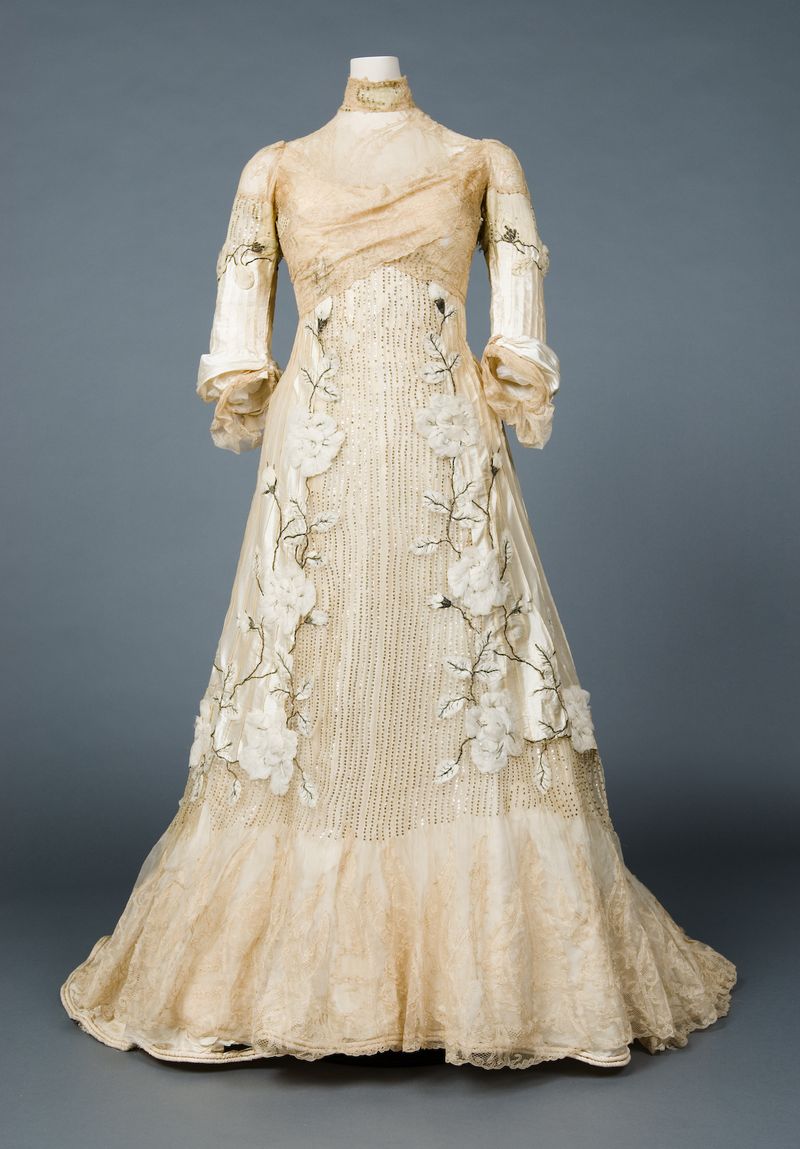 Evening gown
Evening gown
1900
2005.842.22
Gift of Madge Baker
FIDM Museum Collection
My research began with the evening gown you see above, donated to the FIDM Museum in 2005. The gown is part of a collection of about 25 garments and accessories dating from the 1890s to the 1940s worn by Ida Irwin Jones and her daughter Katharine. The items were donated by Katharine’s daughter, Madge Baker. The original wearer of this evening gown must have been Ida who would have been about 28 years old at the time.

The trained evening gown is of ivory silk taffeta and chiffon with ecru lace insertions, applied chiffon flowers embroidered with silver thread and hundreds of vertical pin tucks. But the most striking element is the thousands of dazzling silver sequins that cover the gown in vertical rows.
It has a petersham label, stamped in gold with “M.F. Daly/GOWNS/ 200 West 81st St.” It was let out in the bust and waist to allow for continued wear as Ida developed a more mature figure, perhaps in 1902 after her first child was born.
Shortly after we received this donation, Kevin Jones–my colleague and Curator of the FIDM Museum, happened to be at LACMA’s Doris Stein Center doing research in the book Les Toilettes de la Collectivité de la Couture, Les Chefs D’Oeuvre à l’Exposition Universelle Internationale de 1900. It is a lavish folio of hand painted prints depicting garments displayed on mannequins at the Paris Exposition of 1900. Featured in the folio were gowns by Boué Souers, P. Barroin, and Worth among others. Kevin saw Plate 40–an evening gown by Raudnitz et Cie, described in French as a princess-line, white taffeta gown embroidered with silver paillettes–that was strikingly similar to the FIDM Museum gown pictured above.
Toilette du soir taffeta, Raudnitz et Cie, Plate 40 (detail)
From Les Toilettes de la Collectivité de la Couture, Exposition Universelle Internationale de 1900
Hand-colored engraving on paper
Gift of the Frances & Sidney Brody Charitable Fund in honor of Virginia Oppenheimer, Doris Stein Research Center
Photo courtesy of the Los Angeles County Museum of Art
Our gown is the same as the plate, with only a few minor alterations: a lace modesty piece has been added to the bodice on our gown and the sleeves and train are longer than the plate. The plate is more extreme in silhouette, has colored flowers and more sequins. Comparing the plate with our gown immediately sparked questions. Just how was the gown copied? Did the seamstress or wearer own a copy of this book? Did either attend the Exposition? More generally, what role did fashion play in the exposition? And what did one wear when visiting?
April 14, 1900 was opening day at the Paris Exposition. The Exposition halls, called Palaces, covered 360 acres. It has been reported over 50 million people saw the Exposition during the 6 months it was open. There were 76,000 exhibits–36,000 of those were French, while 40,000 were from abroad. Exhibitors displayed everything from cars to food and livestock to household goods. Countries displayed scientific developments and traditional crafts. New developments in technology were showcased, including x-rays, sound synchronized with moving pictures, wireless communication, and electricity. At night visitors admired the Palace of Electricity and its 5,000 colored incandescent lamps. This palace provided electricity to all of the other buildings.
La Mode Illustrée
September 2, 1900
FIDM Museum Special Collections
A reporter for the The Ladies Home Journal wrote, “I will venture to say there has not been a moment since the Exposition opened when Paris has not been thinking about clothes. Everybody has had such need of them. Each week has brought all sorts of charming breakfasts, and teas, and dinners at the Great Fair…”1 Many fashion plates in La Mode Illustrée depict ensembles to wear to the Exposition. The blue costume-tailleur (pictured above) which appeared on September 2, 1900, is by Mlle Louise Piret. Although not stated directly, this woman is indeed visiting the Exposition. In the background one can see men in non-Western dress speaking with a man in a typical Western suit; a striped palace canopy and flags are in the distance.
The Palais du Fils, Tissus, et Vetements, commonly known as the Palais du Costume, featured contemporary and historic fashions. The Costume Palace displayed contemporary garments by about twenty eminent designers who were members of the Chambre syndicale de la haute couture. Their garments were displayed on lifelike wax figures which occupied staged domestic settings. Quoting an American periodical about the Palais des Costumes, “The art of dressing has never been manifested with so much brilliancy, and, in spite of several men’s names among dressmakers, the art is still chiefly feminine.”2 The electric light illuminating the palace must have contributed to the brilliant effect of the gowns on display, the majority of which were evening gowns covered with reflective embellishments. The Couture folio from LACMA records this brilliancy in the hand-painted silver and gold highlights decorating many of the pages.
Now, let’s return to the United States and Ida Jones, the original wearer of this gown. Granddaughter Madge Baker had provided us with the date of her grandmother’s marriage to Arthur Bacon — November 8, 1900. I did some sleuthing and found a book entitled Woman’s Who’s Who of America 1914-1915 with an entry for “Jones, Ida Irwin, born 1872” which matched the birth date given to us by the family. The book contains entries for about 9,000 women and appears to be a social registry. The listing for Mrs. Arthur Bacon Jones, who lived at 981 Central Av, Plainfield, NJ. states she was a member of the National Child Labor Committee, the National Consumer’s League, the National Progressive Party, the College Club of Plainfield, NJ, the Monday afternoon Club, the Plainfield Country Club and was Presbyterian. She “Favor[ed] woman suffrage” and was educated at Miss Capen’s School in Pittsburgh and Smith College.
I contacted Ms Baker, wanting to know more about her grandmother. She wrote back, “Ida was an active suffragette and an active supporter of Sanger’s work to promote availability of birth control methods. My mother always described Ida as a radical feminist.” I asked if her grandmother could have attended the Exposition. She didn’t know, but noted she did go to Germany to visit relatives shortly before she married. Ida was married in the United States two days before the Exposition closed.
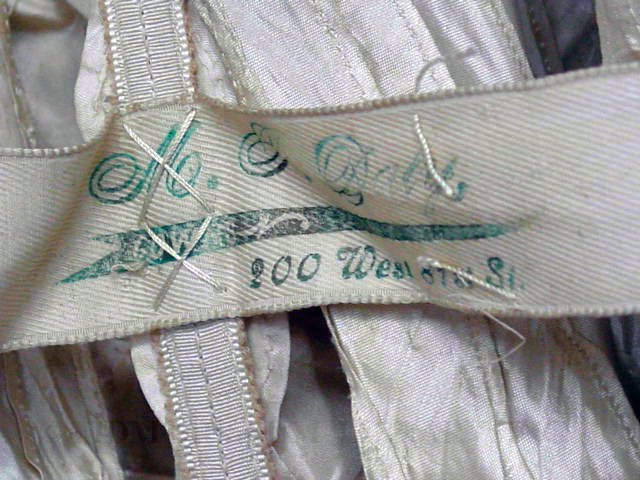 Petersham detail
Petersham detail
2005.842.22
Gift of Madge Baker
FIDM Museum Collection
And what of the woman who made it? The petersham is stamped in gold “M. F. Daly dressmkr, 200 W. 81st Street”. I had a hunch this was 81st street in Manhattan. The 1900 Manhattan City Directory identifies a Mary F. Daly as resident of an apartment building at this address, although her rooms were listed as a business. The 1900 Census confirms Mary F. Daly, the only Mary F. Daly in Manhattan, as living on West 81st Street. She is listed as a single, 36 year old dressmaker living with Hope Arnold, another dressmaker. They had one servant. The census shows Daly was born in 1863 in New York. Her mother was born in New York and her father, in Ireland. The 1880 census had recorded Daly as a household servant.3
How did the gown come to be copied? Was it based on an image or an unauthorized French pattern? Starting out my research, I hypothesized the gown was copied in Manhattan and not imported whole because evening gowns were not mass-produced at this time. The sewing of the gown is on the level of an average dressmaker. Did the idea to recreate the gown come from dressmaker or client? I believe Daly’s socioeconomic level may have precluded her from attending the Exposition. Perhaps Ida did travel to the Exposition, brought back an image, and had it copied as a souvenir? Or she showed her dressmaker one of the many published images of the gown available in the United States?
I wondered if American periodicals published images of the Exposition couture garments. I looked at The Pictorial Review–a magazine published in Manhattan for a dressmaker and home-sewer audience. The September 1900 edition featured a notice: “Pictorial Review for October will contain exact reproductions, from photographs on the spot, of 48 costumes by the leading dressmakers of Paris. Worth, Paquin, Doucet and others will be represented.” Inside, 33 images of gowns on display, including our Raudnitz copy! And each with a pattern available for one dollar.
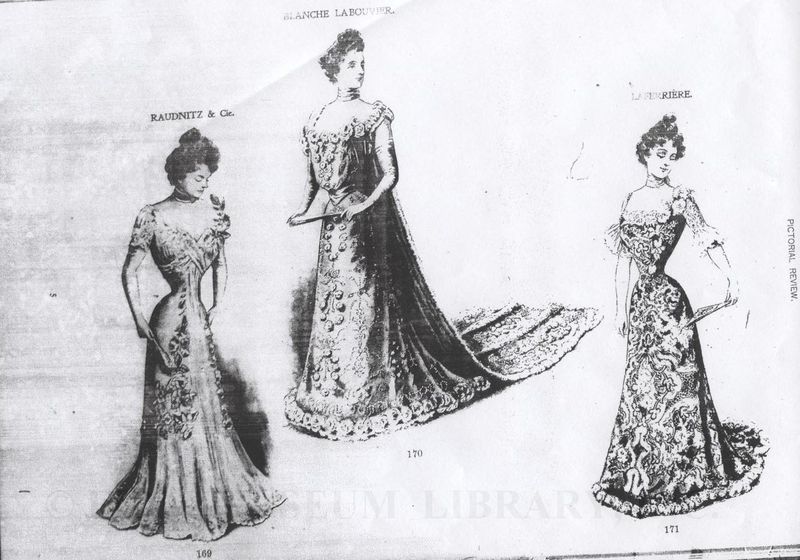 Pictorial Review
Pictorial Review
October 1900
The Raudnitz et Cie gown is pictured at far left.
Over the next three months, over 50 patterns of the Exposition gowns were offered. It is highly likely Daly had access to The Pictorial Review or another magazine like it and worked from a pattern. Perhaps she had a copy of The Pictorial Review, and it was available for clients to peruse in her rooms. It may have even acted as a sort of catalog.
Just before I completed this paper, Ms Baker mailed me a few more photographs of her grandmother. I gasped when I saw this one, an undated image of Ida wearing our gown.
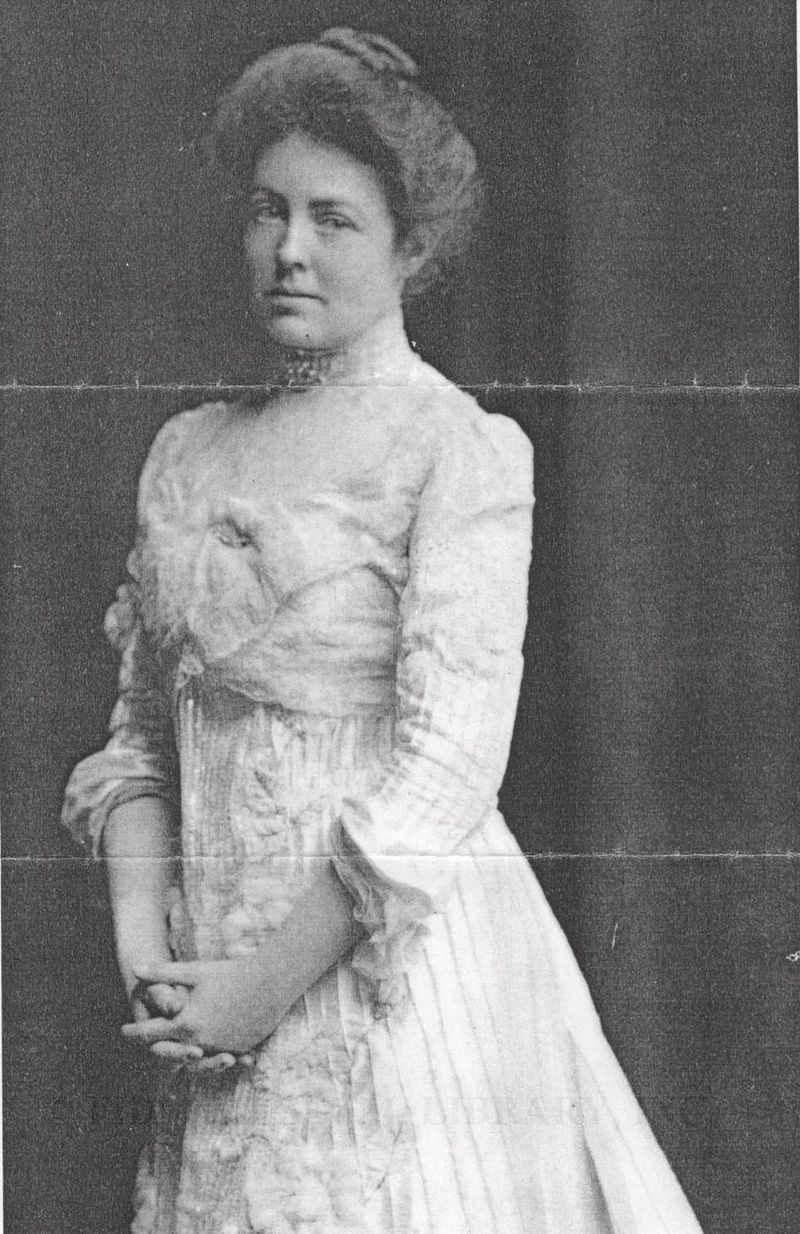 Ida Irwin Jones
Ida Irwin Jones
c. 1900
Copy of photograph courtesy of Madge Baker
1 De Forest, Katharine. “Miss Forest’s Letter from Paris” The Ladies’ Home Journal. Sep 1900. 11.
2 “Woman at the Paris Exhibition” Outlook Sep 29, 1900. 260.
3 Thank you to Shelly Foote, for help with Census research.


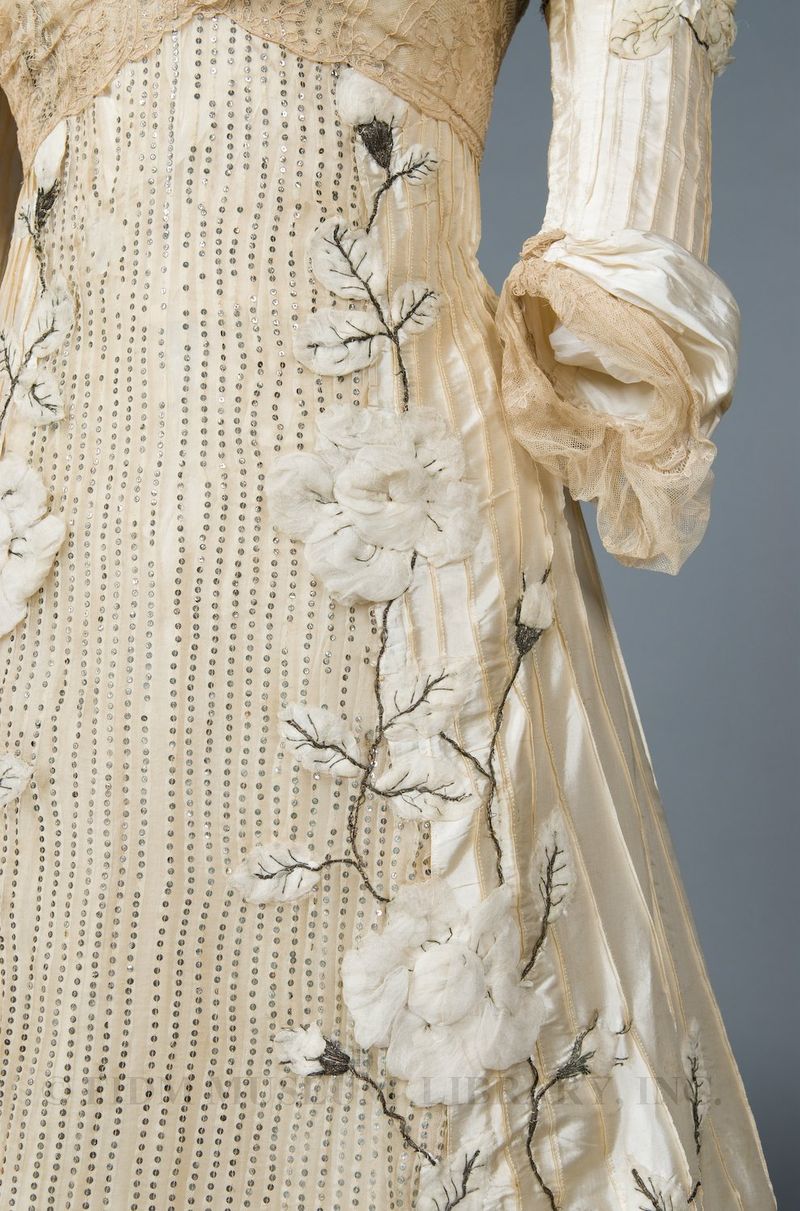

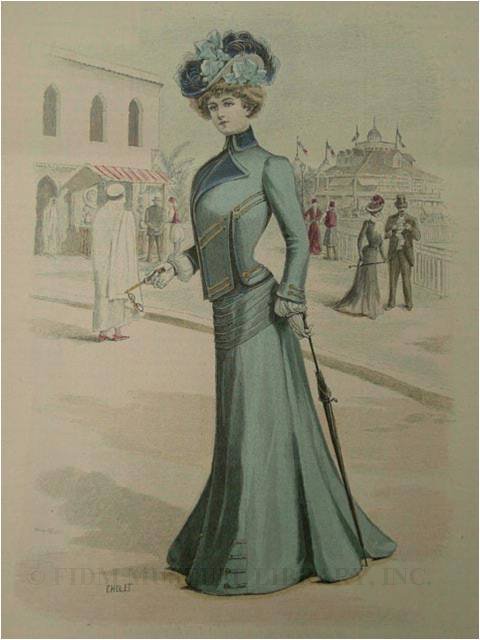
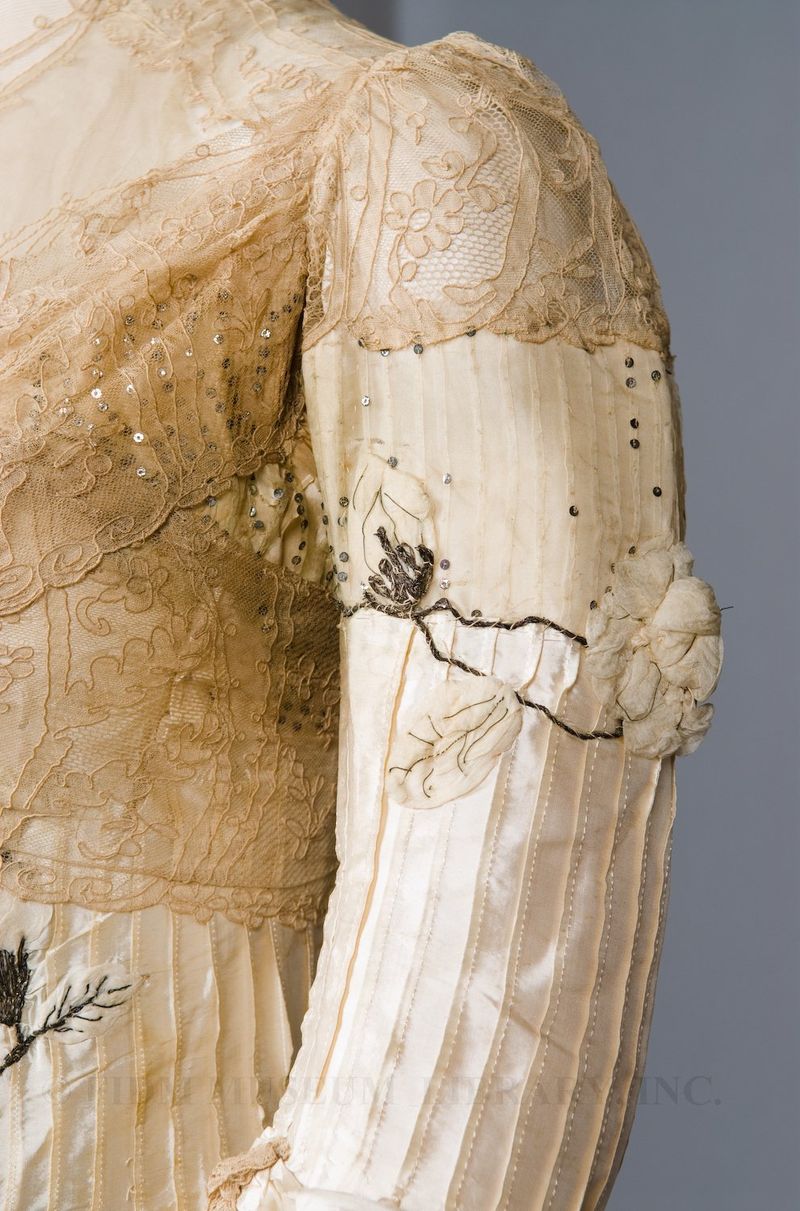

This gown is so stunning,are there any more detailed notes on how it is put together?